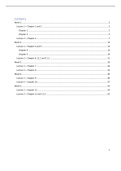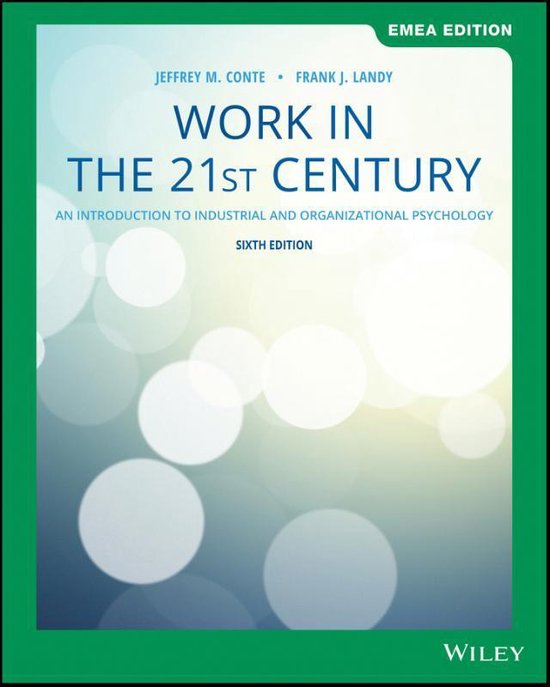Contents
Week 1........................................................................................................................................................... 2
Lecture 1 – Chapter 1 and 2 ...................................................................................................................... 2
Chapter 1 ............................................................................................................................................... 2
Chapter 2 ............................................................................................................................................... 5
Lecture 2 – Chapter 3 ................................................................................................................................ 7
Week 2......................................................................................................................................................... 13
Lecture 1 – Chapter 4 and 5 .................................................................................................................... 13
Chapter 4 ............................................................................................................................................. 13
Chapter 5 ............................................................................................................................................. 19
Lecture 2 – Chapter 6, 11.1 and 11.2 ...................................................................................................... 21
Week 3......................................................................................................................................................... 26
Lecture 1 – Chapter 7 .............................................................................................................................. 26
Lecture 2 – Chapter 8 .............................................................................................................................. 33
Week 4......................................................................................................................................................... 40
Lecture 1 – Chapter 9 .............................................................................................................................. 40
Lecture 2 – chapter 10............................................................................................................................. 47
Week 5......................................................................................................................................................... 54
Lecture 1 – chapter 12............................................................................................................................. 54
Lecture 2 – Chapter 13 and 11.3 ............................................................................................................. 62
1
,Week 1
Lecture 1 – Chapter 1 and 2
Chapter 1
Why do people work?
o Money – buying things for surviving or pleasure.
Would people still do the work if they did not need the money?
Most people would keep working if they had the opportunity to stop. So, there are other reasons beside
money to work.
Work = Service, Expertise, Providing to society/world, Talent/passion
Good work = work that exhibits high level of expertise and entails regular concern with the implications
and applications of an individual’s work for the wider world.
The individual worker and the employer together have the power to transform bad work to good
work and vice versa.
Authenticity = an emotionally appropriate, significant, purposive and responsible mode of human life.
Work values (reasons to work / What is important in work for certain individuals).
Intrinsic values > interesting work, challenging work, learning new things, making important
contributions, responsibility and autonomy, being creative.
Extrinsic values > pay, social contacts, status in wider community.
I-O psychology (Industrial organizational psychology)
= The application of psychological principles. Theory, and research to the work setting.
Many of the factors that influence work behavior are not always found in the work setting. So, we also
look beyond the work setting: personal life, personality.
It helps develop strategies that build better organizations.
Selection and placement
Training and development
Quality of work life
Engineering psychology
Organizational development
Performance measurement
I-O psychologists = a scientist who derives principles on individual, group and organizational behavior
through research. They are employed at public and private organizations.
Helping organizations with
o staffing and workforce development
o Enhancing motivation, team effectiveness, and organizational development
o Work design and workplace issues.
2
,Personnel psychology = field of psychology that addresses issues such as recruitment, selection, training,
performance, appraisal, promotion, transfer, and termination.
Human resource management = practices such as recruitment, selection, retention, training, and
development of people in order to achieve individual and organizational goals.
Organizational psychology = field of psychology that combines research from social psychology and
organizational behavior and addresses the emotional and motivational side of work.
Human engineering/human factors psychology = the study of the capacities and limitations of humans
with respect to a particular environment.
Scientist-practitioner model: using scientific tools and research in the practice of I-O psychology.
This means that science and practice are both important parts of I-O psychology.
Welfare-to-work program = program that requires individuals to work in return for government
subsidies.
Telecommuting = accomplishing work tasks from a distant location using electronic communication
media.
Virtual team = Team that has widely dispersed members working together toward a common goal and
linked through computers and other technology.
History of I-O psychology
1876 – 1930
o Stanford-Binet test = a well-known intelligence test designed for testing one individual at a time.
Scientific management = There is one best and most efficient way to perform various jobs.
Time and motion studies = Studies that broke every action down into its constituent parts,
timed those movements and developed new and more efficient movements that would reduce
fatigue and increase productivity.
1930 – 1964
o Revery obsession = a mental state that resulted from the mind-numbing, repetitive, and difficult
work that characterized U.S. factories. Causing employees to be unhappy and not wanting to
increase productivity.
Hawthorne studies = attempts to increase productivity by manipulating lighting, rest breaks, and
work hours. It showed the important role of worker’s attitudes in productivity.
Human relations movement = the result of the Hawthorne studies ushered in this movement,
which focused on work attitudes and the newly discovered emotional world of the worker.
Title VII of the civil rights act = prohibition of discrimination of the basis of race, color, religion,
sex or national origin.
Present
o American psychological Association (APA) = the major professional organization for psychologist
of all kinds in the U.S.
3
, The future
o 4 challenges:
I-O psychology needs to be relevant > study the problems of today, not yesterday.
I-O psychology needs to be useful
I-O psychology needs to think bigger > not only focus on individuals, but on larger
problems.
I-O psychology needs to be grounded in the scientific method.
Culture = a system in which individuals share meanings and common ways of viewing events and objects.
I-O psychology is a multilevel science.
West versus rest mentality = tendency for researcher to develop theories relevant to U.S. situations,
with less concern given to their applicability in other countries.
Expatriate = manager or professional assigned to work in a location outside of his or her home country.
Collectivistic culture = a culture that values the group more than the individual.
Individualistic culture = a culture that values the individual more than the group.
4






